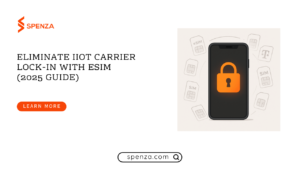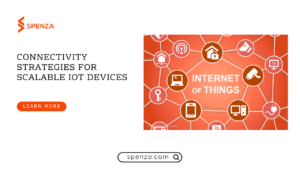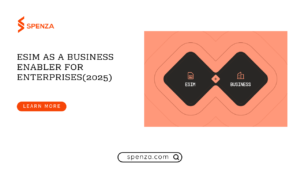Table of Contents
- Introduction
- What Is eSIM and Why It Matters in IoT
- Top eSIM IoT Trends in 2025
- Widespread Adoption of SGP.32 Standard
- AI + IoT (AIoT) Integration
- Rise of Edge Computing for IoT
- Satellite Connectivity for Remote IoT
- Enhanced IoT Security Protocols
- Benefits of eSIM for IoT Applications
- Challenges in eSIM Deployment for IoT
- Industry Use Cases in 2025
- Future Outlook: What’s Next for eSIM in IoT
- Conclusion
- FAQs

Introduction
In 2025, businesses need smarter ways to connect their devices. Physical SIM cards make it harder to manage connections, especially for large-scale IoT systems. That’s where eSIM steps in. eSIM is not just a tiny chip inside a device. It’s a smarter way to stay connected across multiple networks without swapping cards.
As IoT grows, so does the need for better, faster, and more flexible connectivity. This is why IoT eSIM trends 2025 are important for every tech-driven company. These trends help improve performance, security, and scalability across industries. In this blog, we look at what’s shaping IoT eSIM in 2025 and what you need to know to stay ahead.
eSIM in IoT: Why It Matters More Than Ever
eSIM, short for embedded SIM, is already replacing physical SIM cards in smartphones. Now, it’s growing fast in IoT. The reason is simple. eSIM removes the need to manually insert a SIM into a device. This makes it easier to manage hundreds or thousands of devices in different locations. eSIM supports remote provisioning. You can update settings or switch networks over-the-air.
This flexibility means faster rollouts and lower costs. Businesses can switch carriers without changing hardware. This helps with global IoT connectivity eSIM needs. More manufacturers now include eSIM in smart meters, connected vehicles, and industrial machines.
And the demand is rising. eSIM adoption in IoT is strong. The market keeps growing with newer features and better standards. Companies now look for simple ways to manage everything from one place. That’s why platforms like Spenza are gaining attention.
Spenza is an IoT connectivity aggregation platform. It helps connect, manage, and scale IoT devices easily. You can bulk import subscriptions, SIMs, devices, users, and plans—all in one place.
You can also read more about how eSIM is transforming IoT connectivity in this article.
IoT eSIM Trends 2025: What to Watch For
IoT eSIM trends 2025 are changing how businesses plan and operate. From new tech standards to AI, many shifts are happening now. Here’s what matters most.
1. New Standard: SGP.32 Adoption Grows Fast
SGP.32 is the latest eSIM standard. It builds on past ones like SGP.22 but adds more features. Businesses like it because it supports both consumer and M2M (machine-to-machine) profiles. That means fewer device versions and better control over provisioning.
Remote provisioning becomes even smoother. You can control when and how devices connect to different networks. This means less delay during setup and better uptime. IoT device management eSIM tools must support SGP.32. Also, the number of connected devices worldwide is expected to nearly double from 2023 to 2029. The demand for better standards like SGP.32 will only rise.
Learn how to choose the right cost structure in this guide on IoT eSIM pricing models.
2. Smarter Systems: AI and IoT Work Together
AI is no longer a buzzword. It helps manage and analyze IoT data in real-time. With eSIM, AI systems can monitor which network works best and make fast switches. This ensures devices always stay online, even during outages.
In IoT device management eSIM setups, AI helps predict failures before they happen. It supports energy-saving by switching to low-power networks when needed. This makes AI and eSIM a strong combo in IoT.
You see this trend in smart factories, logistics, and agriculture. Devices keep working with minimal human input. Businesses see real gains in time and cost.
3. Edge Computing Moves Closer
Edge computing means processing data near the device instead of sending it to the cloud. This reduces delay and helps faster decisions. It matters a lot when using eSIM for IoT. With eSIM, devices can connect to the closest and best available network. Combined with edge computing, they send only important data back to the cloud. The rest is handled locally.
This trend supports use cases like industrial robots and traffic systems. Devices don’t wait on faraway servers to act. Everything happens faster and smarter.
4. Satellite Networks Help Remote IoT
eSIM works not only with cellular networks. Now, it works with satellites too. This opens new areas for IoT. Places with no 4G or 5G can still get connected. The U.S. leads the world with 72 million eSIM IoT connections as of 2024. Other countries follow but are still far behind. The gap makes satellite support even more useful.
Here’s a comparison of satellite-ready eSIM features:
| Feature | Traditional SIM | Cellular eSIM | Satellite eSIM |
|---|---|---|---|
| Remote Provisioning | No | Yes | Yes |
| Works in Remote Areas | No | Limited | Yes |
| Switch Networks | Manual | Auto | Auto |
| Setup Time | Long | Short | Short |
| Cost Over Time | High | Medium | Low |
Industries like mining, shipping, and forestry use satellite-connected eSIMs for reliable communication in tough zones.
5. Better Protection: Stronger Security Layers
As eSIM grows, so do threats. Hackers look for new ways to break systems. That’s why security becomes a big trend in IoT eSIM trends 2025. New protocols now support stronger encryption and user checks. Devices must prove who they are before connecting. This reduces fraud and misuse. Also, remote locking and wiping help protect sensitive data. If a device gets lost, companies can act fast. These steps lower risk and increase trust in eSIM technology IoT users rely on.
Why eSIM Works for IoT
eSIM benefits for IoT go beyond just easy setup. Here’s what companies see when they switch.
Always-On Global Access
Devices move. Trucks, ships, and wearables change locations daily. eSIM allows devices to stay connected across borders. Businesses don’t need to worry about which network works where. Global IoT connectivity eSIM setups let you add local carrier profiles instantly. This helps cut roaming costs and keeps data flows smooth.
For a broader comparison, check out how SIM and eSIM compare in IoT applications.
Fewer SIM-Related Issues
Physical SIMs break or get lost. Not with eSIMs. They are built into the device, sealed from the outside. This means fewer service calls and lower support costs. Field teams don’t carry spare cards. That cuts clutter and speeds up work.
Easier Subscription Handling
With platforms like Spenza, managing connections gets even simpler. Spenza simulates operator contracts. It shows all subscriptions in one dashboard. Bulk updates make managing SIMs, devices, and plans super easy. You don’t log in to multiple portals anymore. Spenza does the heavy lifting.
Challenges When Using eSIM for IoT
- Not all devices support eSIM yet
- Some networks delay adopting new eSIM standards
- Switching between carriers may need contracts
- Lack of training slows internal teams
- Older systems can block eSIM updates
- Limited satellite coverage in some regions
- High initial cost for new infrastructure
Who’s Using eSIM for IoT in 2025?
eSIM is not future tech anymore. It’s already being used widely. Here are some use cases :

- Smart Logistics: Companies track goods across borders using eSIM-enabled trackers.
- Healthcare Devices: Remote patient monitors send real-time data to doctors.
- Smart Cities: Public bikes, lights, and parking systems stay connected 24/7.
- Agriculture: Farmers use soil sensors and drones with eSIMs to monitor crops.
- Utilities: Smart meters send usage data without human effort.
What’s Ahead: Future of IoT Connectivity
Things will keep changing. Here are expected changes from now till 2030:
| Area | 2025 | 2027 | 2030 |
|---|---|---|---|
| Satellite eSIM Use | Low | Medium | High |
| AI-Based SIM Switching | Basic | Smart | Real-time |
| Standardization | SGP.32 | Unified Global | Enhanced APIs |
| Security | Strong | Stronger | Zero Trust Models |
| Network Partners | Few | Many | Global Roaming Hubs |
| SIM Lifecycle Tools | Manual | Hybrid | Automated |
The Rise of eSIM in Consumer Tech
Consumer electronics are quickly moving toward eSIM support. Smartphones, wearables, tablets, and laptops now come with eSIM options. This shift helps manufacturers reduce hardware space, simplify logistics, and lower shipping costs. More importantly, it allows users to activate devices in minutes without store visits.
Smartwatches use eSIM to offer phone-free features like calling, location sharing, and streaming. Fitness trackers and health wearables use eSIM to push real-time updates to caregivers.
As these devices evolve, the demand for seamless, flexible connectivity increases. eSIM offers exactly that. In fact, embedded SIM trends are now focused on enhancing user experience. With eSIM, users can change network providers in minutes. For IoT companies serving consumers, this shift means offering scalable plans that adapt to changing user needs.
Conclusion: IoT eSIM Trends 2025 Point to a Connected Future
It’s clear that IoT eSIM trends 2025 will change how devices stay online. With smarter networks, better security, and easier setup, more companies will make the switch. From tracking tools to connected machines, eSIM makes things faster and more flexible.
FAQs
eSIM is a built-in chip that connects IoT devices to networks without using physical SIM cards anymore.
It enables remote provisioning, so you can activate or switch networks without touching the device.
Logistics, agriculture, healthcare, utilities, and smart cities benefit a lot by using eSIM in their devices.
No, only newer devices support eSIM but most brands are switching fast in 2025 and beyond.
eSIM comes with strong encryption and remote locking, making it safer than traditional SIMs.
Yes, satellite eSIMs give coverage in remote zones where there is no 4G or 5G available.
SGP.32 works for both M2M and consumer profiles while SGP.22 was limited to only M2M use.
If you’re planning your IoT strategy, now’s the time to act. Consult Spenza to simplify your IoT connections and stay ahead.





